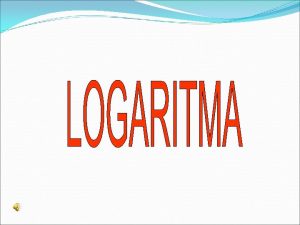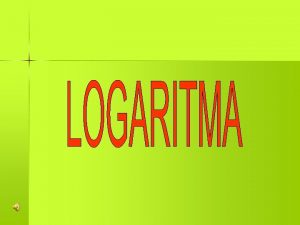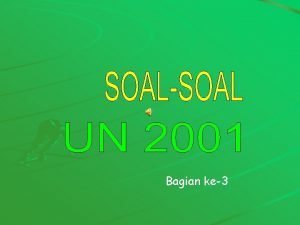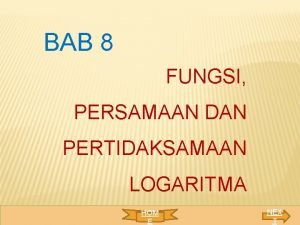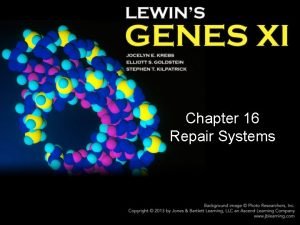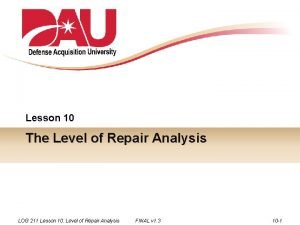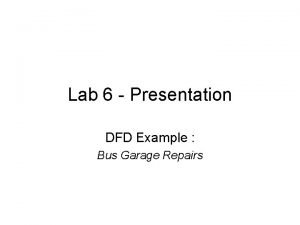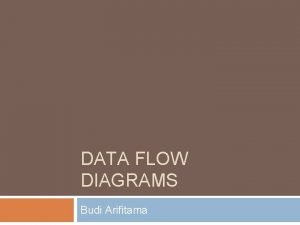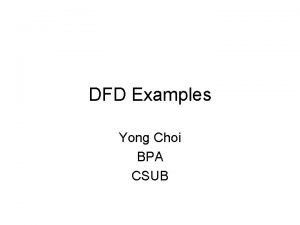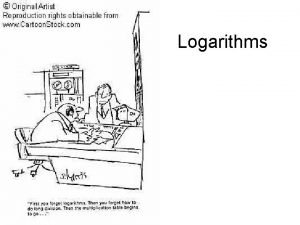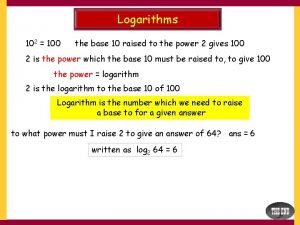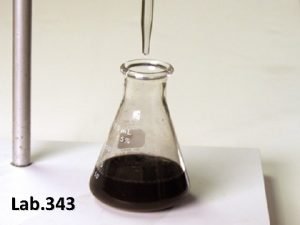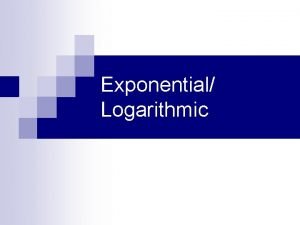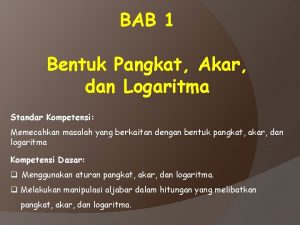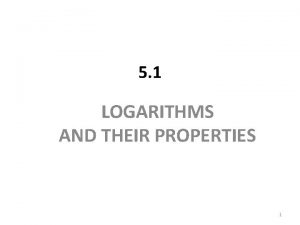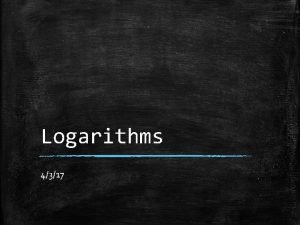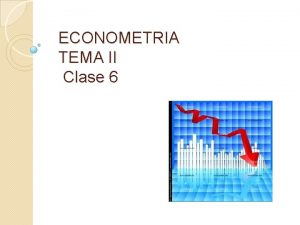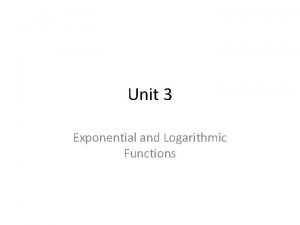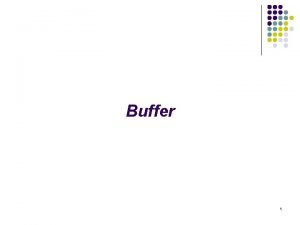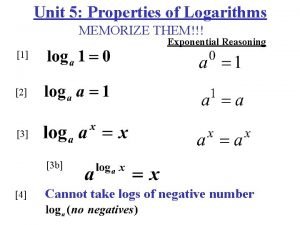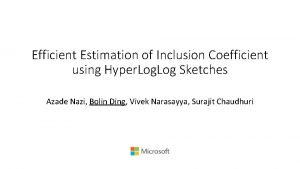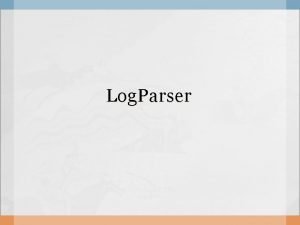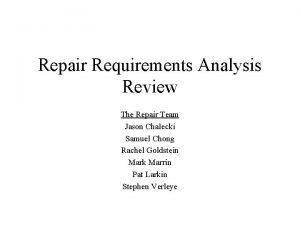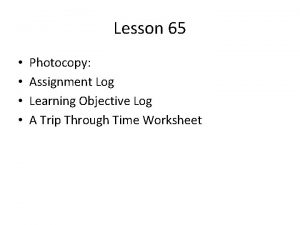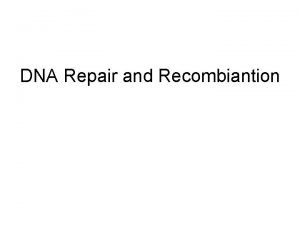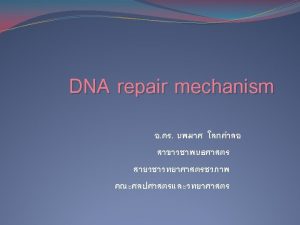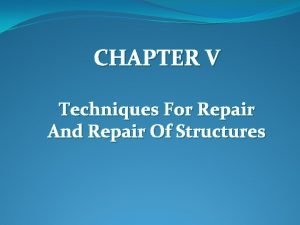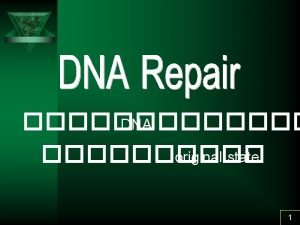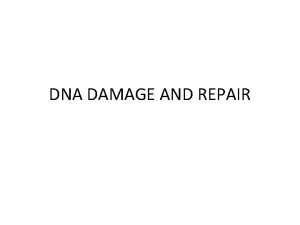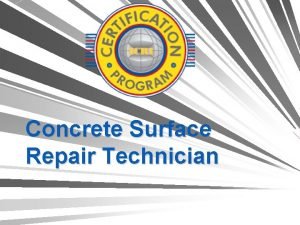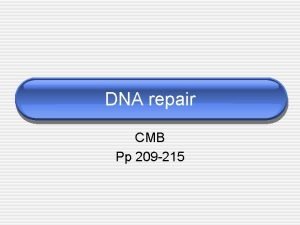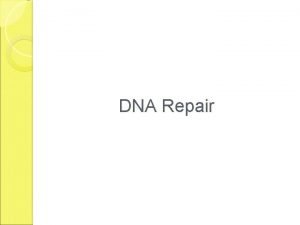Lesson 10 The Level of Repair Analysis LOG















































- Slides: 47

Lesson 10 The Level of Repair Analysis LOG 211 Lesson 10: Level of Repair Analysis FINAL v 1. 3 10 -1

Topic 1: Introduction What’s in it for me? Level of Repair Analysis (LORA) is conducted to determine the least cost feasible repair level or discard alternative for performing maintenance actions and to drive equipment design in that direction. The LORA is conducted to reflect maintenance policy and the capabilities of maintenance organizations with respect to the number of maintenance levels, their diagnostic capabilities and the skill sets and skill levels of their staff. LORA uses cost data, and data from Reliability & Maintainability (R&M) analyses to include Reliability Allocation and Prediction, FMECA/FTA, RCM, CBM+, and the detailed procedures of the Maintenance Task Analysis (MTA) to balance Operational Availability and the cost of maintenance. LORA outputs drive the Product Support Strategy and the Product Support Package by verifying the system’s maintenance requirements and identifying the resources required for effective support. LOG 211 Lesson 10: Level of Repair Analysis FINAL v 1. 3 10 -2

Life Cycle Management Framework Where Are You? What Influence Do You Have? Technology Maturation & Risk Reduction You are Here Adapted from GEIA-HB-0007 LOG 211 Lesson 10: Level of Repair Analysis FINAL v 1. 3 10 -3

Non-Economic & Economic LORA Non-Economic LORA Analyzes only gross concepts by conducting a non-economic analysis to influence design from a supportability standpoint Details economic alternatives and uses tools to perform analyses such as: Technology Maturation & Risk Reduction LOG 211 Lesson 10: Level of Repair Analysis • • Front End Analysis Sensitivity Analysis Optimizer Analysis Evaluator Analysis FINAL v 1. 3 10 -4

ASOE Model 1 The ASOE model has four distinct intersections 2 representing impacts of tradeoffs on program performance and sustainment objectives. Balancing these priorities require a series of trade-off analyses. Technical Performance 3 Supportability Process Efficiency • Functions • Reliability • Production • Capabilities • Maintainability • Maintenance • Support Features • Logistics Life Cycle Cost Total Ownership Cost • Operations 1 2 Design Effectiveness 3 Affordability Mission Effectiveness Affordable System Operational Effectiveness LOG 211 Lesson 10: Level of Repair Analysis FINAL v 1. 3 10 -5

LORA Lesson Approach This lesson emphasizes the LCL’s role in determining the optimal maintenance approach within the constraints of maintenance policy. Validate data and load model Run LORA tool reports and evaluate outputs to determine recommendations Report recommendations and findings to Lead Logistician/IPT LOG 211 Lesson 10: Level of Repair Analysis FINAL v 1. 3 10 -6

Topics and Objectives TLO: Conduct Level of Repair Analysis (LORA)) Topic Objectives Topic 1: Introduction • • Welcome Where Are You? What Influence Do You Have? Topic 2: Overview of the LORA • • Relate the LORA to Supportability and Supportability Analysis Relate the LORA to the Product Support Package Relate the LORA to the Maintenance Concept • Compare system design elements (reliability/availability, component attributes) with the sustainment factors evaluated as part of the LORA (reliability/availability, component attributes, manpower, equipment/facilities, administrative activities) Topic 4: Conducting the LORA and Reporting Findings • Compare the data contained in the Logistics Product Database with the trade-off criteria used to make LORA determinations Topic 5: Exercise and Simulation • Analyze the impact of the LORA on Supportability and the Supportability Analysis Topic 3: Setting Up the LORA Topic 6: Summary LOG 211 Lesson 10: Level of Repair Analysis FINAL v 1. 3 10 -7

Topic 2: Overview of the LORA LOG 211 Lesson 10: Level of Repair Analysis FINAL v 1. 3 10 -8

Purpose of the LORA “The purpose of the LORA is to establish the least-cost, feasible repair level or discard alternative for performing maintenance actions and to influence the equipment design in that direction. ” – Level of Repair Analysis MIL-STD-1390* Line Replaceable Unit (LRU) How to Acquire Level authorized to Remove and Replace Level authorized to perform Repair Level authorized to make Disposition Determination Conforms to Policy Conforms to Budget *MIL-STD-1390 was cancelled in 1997 and replaced by MIL-PRF-49506, Logistics Management Information. MIL-PRF 49506 was cancelled in 2005 and replaced by SAE GEIA-STD-0007 Logistics Product Data. LOG 211 Lesson 10: Level of Repair Analysis FINAL v 1. 3 10 -9

Requirements • Maintenance Concept • CDD/CPD • • Outputs Reliability • Reliability Block Diagrams (RBD) • FMECA/FTA • Predictions & Actuals – MTBF, MTTR, etc. System Definition Maintainable Item List Equipment cost and Availability Skill levels and cost Operational Profile Supply Chain • Catalog Data • Turnaround times • Transportation delays and costs LORA Process Inputs The Role of the LORA in Supportability Analysis AO Recommend • SM&R code updates: ― Requisitioning information ― Maintenance echelon authorization ― Disposition instructions • SRU to LRU Promotions $ Refine Analysis • Input approved SM&R code updates into ― MTA refinement ― Logistics Product Data • Input Total Logistics Cost and AO estimates into BCA LOG 211 Lesson 10: Level of Repair Analysis FINAL v 1. 3 Update Planning • Product Support Analysis verifies LORA was conducted • Provides input to LCSP, via the PSP ― Life Cycle Cost Estimates ― Sensitivity Analysis results ― Optimization Results ― Evaluation of trade-off results (cost of employing policies or alternative strategies) 10 -10

The Maintenance Concept & the LORA The LORA examines the Sustainment strategy determined through preceding analyses for compliance with Reliability, Availability, and Maintainability requirements mandated by the Maintenance Concept, and evaluates the cost of meeting those requirements. Sustains Mandates Sustainment Strategy Tasks LORA Evaluates AO $ Equipment Manpower Components LOG 211 Lesson 10: Level of Repair Analysis FINAL v 1. 3 10 -11

Supporting Analyses to the LORA Identifies significant failure modes mitigated by maintenance tasks FMECA FTA Provides preliminary MTBF and MTTR MTA R&M For required maintenance tasks, identifies: • Skill level • Labor hours • Equipment LORA Ao LOG 211 Lesson 10: Level of Repair Analysis FINAL v 1. 3 $ 10 -12

Topic 3: Setting Up the LORA LOG 211 Lesson 10: Level of Repair Analysis FINAL v 1. 3 10 -13

LORA Set Up 1. 2 1. 1 1. 4 1. 3 Build Plan Define LORA Data Inputs Define Support Environment Iterate Plan Collect /Load Tech Data Define Assumptions Front End Analysis Our planning considers four main areas: 1. 1 Project Management – Defines schedule, responsibilities, and face-to-face updates 1. 2 Data Management – Identifies authoritative data and collection format 1. 3 Supportability Environment – Defines the product support structure, assumptions, and policies 1. 4 Front End Analysis – Detect errors; format input data for summary report and analysis LOG 211 Lesson 10: Level of Repair Analysis FINAL v 1. 3 10 -14

LORA Process – Set Up Run Sensitivity and Trend Analysis Run Front End Analysis Run Optimizer Edit Model’s Maintenance Policy Report Build/Validate Models Analyze Set Up. . Integrate Data Report Findings Evaluate Impact of Policy Edits LOG 211 Lesson 10: Level of Repair Analysis FINAL v 1. 3 10 -15

LORA Data Management 1 SAE GEIA-STD- LORA Tool Import Template 3 LORA Tool Economic Factors Approved 0007 Logistics Product Data 2 6 Integrated Project Team (IPT) 5 Recommended LOG 211 Lesson 10: Level of Repair Analysis Maintenance Allocation Determinations FINAL v 1. 3 4 LORA Tool Edit Policy 10 -16

LORA Input Data 1 SAE GEIA-STD- 0007 Logistics Product Data 2 LORA Tool Import Template LSAR 080 Bill of Material LOG 211 Lesson 10: Level of Repair Analysis 3 LORA Tool Economic Factors LSAR 023 Maintenance Summary FINAL v 1. 3 10 -17

LORA Elements Cost Metrics: • MTBF • MTTR Component: • End Item • LRU • SRU $ Administrative: • Cataloging • Requisitions • Tech Manuals Personnel: • Availability • Skill level • Cost Facility LORA Transportation: • Financial Cost • Time Delay LOG 211 Lesson 10: Level of Repair Analysis FINAL v 1. 3 Ao $ 10 -18

The Supportability Environment In conjunction with the CDD, the Maintenance Concept defines the supportability environment. Depot Level Master Depot $ . 5 day $$$ 3 days $$ 2 days $$$ 4 days Journeyman $ 1 day Field OEM Journeyman Distribution Center Field Level OEM Master Field Apprentice LOG 211 Lesson 10: Level of Repair Analysis FINAL v 1. 3 10 -19

COMPASS Tool Supportability Environment Input Screen LOG 211 Lesson 10: Level of Repair Analysis FINAL v 1. 3 10 -20

Front End Analysis 1 SAE GEIA-STD- 0007 Logistics Product Data SRU Name 2 3 LORA Tool Import Template LRU Name SPLITTER ANALOG ASSEMBLY ST UAV SAT ANTENNA DRIVE ELECT 1 LORA Tool Economic Factors MTBF MTTR 8889. 00 6 CONTROLLER PWR/DISC 222. 22 4 ANTENNA DRIVE ELECT 2 CONTROLLER PWR/DISC 22222. 22 4 ANTENNA RADALT 1 TRANSPONDER UAV Low MTBF LOG 211 Lesson 10: Level of Repair Analysis FINAL v 1. 3 24 Missing Input High MTTR 10 -21

COMPASS Tool Front End Analysis Output Screen 8889 LOG 211 Lesson 10: Level of Repair Analysis FINAL v 1. 3 10 -22

Topic 4: Conducting the LORA and Reporting Findings LOG 211 Lesson 10: Level of Repair Analysis FINAL v 1. 3 10 -23

LORA Analyses Our analysis consists of three main areas: 2. 1 Sensitivity Analysis – Identifies variables sensitive to variation 2. 2 Optimization Analysis – Provides the least-cost maintenance policy for each LRU/SRU 2. 3 Trade-off Analysis – Implements original policy constraints instead of least-cost recommendations and determines impact 2. 1 Sensitivity 2. 2 Optimization 2. 3 Trade-off / Evaluation Iterative Analysis LOG 211 Lesson 10: Level of Repair Analysis FINAL v 1. 3 10 -24

LORA Process – Analysis Run Sensitivity and Trend Analysis Run Front End Analysis Run Optimizer Edit Model’s Maintenance Policy Report Build/Validate Models Analyze Set Up. . Integrate Data Report Findings Evaluate Impact of Policy Edits LOG 211 Lesson 10: Level of Repair Analysis FINAL v 1. 3 10 -25

Optimizer Analysis Original Maintenance Policy Constraints LCL evaluates inconsistencies between original maintenance policy and least-cost recommendations Optimizer Report $ Least-cost Maintenance Recommendations Baseline $ Y IONS C I OL ERAT P NO NSID CO LOG 211 Lesson 10: Level of Repair Analysis FINAL v 1. 3 10 -26

LORA Least-cost Decision Tree Failed Item 1. On. Equipment Repair? Yes Repair in Field No 2. Remove & Replace A. Discard B. Repair Return to Stock Remove & Replace in Field, Discard Failed Item 3. Is Depot Capable? Yes Repair at Depot No 5. Use Economic and Non-Economic Methods/Models LOG 211 Lesson 10: Level of Repair Analysis C. Repair Return to Unit 4. Is OEM Capable? FINAL v 1. 3 Yes Repair at OEM 10 -27

Analyzing Optimizer Report Output Sample Scenarios: A – Inaccurate SM&R code B – Change maintenance policy, Level C – Change maintenance policy, Discard COMM/NAV Name LRU Name A TALON COMM/NAV SPLITTER ANALOG B TALON COMM/NAV C TALON COMM/NAV SRU Name Tool’s Recommended Approach Original Maintenance Policy LRU Rep LRU Orig Rep SRU Orig Rep ASSEMBLY ST UAV SAT ORG DEP ANTENNA DRIVE ELECT 1 CONTROLLER PWR/DISC DEP DEP ANTENNA RADALT 1 TRANSPONDER UAV TOSS LOG 211 Lesson 10: Level of Repair Analysis FINAL v 1. 3 10 -28

COMPASS Tool Optimizer Report Output Screen LOG 211 Lesson 10: Level of Repair Analysis FINAL v 1. 3 10 -29

Editing Maintenance Policy Previous Policy SRUs are repaired at Depot level. COMM/NAV Name TALON COMM/NAV LRU Name ANTENNA DRIVE ELECT 1 Edit Policy Proposed Policy COMM/NAV Name TALON COMM/NAV SRU Name CONTROLLER PWR/DISC LRU Rep LRU Orig Rep SRU Orig Rep DEP DEP LRU Name SRU Name ANTENNA CONTROLL ER COMM/ NAV LRU SRU ORG DEP ORG Specific SRUs are repaired at Organizational level. LRU Name ANTENNA DRIVE ELECT 1 SRU Name CONTROLLER PWR/DISC LOG 211 Lesson 10: Level of Repair Analysis FINAL v 1. 3 LRU Rep LRU Orig Rep SRU Orig Rep DEP ORG DEP 10 -30

COMPASS Tool Edit Policy Screen LOG 211 Lesson 10: Level of Repair Analysis FINAL v 1. 3 10 -31

Analyzing Evaluator Report Output Optimizer ORG Shops: INT 1 Shops: INT 2 Shops: DEP Shops: Summary 100 0 0 1 System Life: Density (# of systems): Total Maintenance Policy: Availability Achieved: 20 Years 350 $150, 000 79. 99% Maintenance Policy COMM/NAV Name TALON COMM/NAV LRU Name ANTENNA DRIVE ELECT 1 SRU Name CONTROLLER PWR/DISC Evaluator ORG Shops: INT 1 Shops: INT 2 Shops: DEP Shops: LRU Rep LRU Orig Rep SRU Orig Rep DEP DEP ORG DEP Summary 100 0 0 1 System Life: Density (# of systems): Total Maintenance Policy: Availability Achieved: 20 Years 350 $152, 000 80. 00% Maintenance Policy LOG 211 Lesson 10: Level of Repair Analysis FINAL v 1. 3 10 -32

COMPASS Tool Evaluator Report Output Screen LOG 211 Lesson 10: Level of Repair Analysis FINAL v 1. 3 10 -33

COMPASS Tool Opt/Eval Report Output Screen LOG 211 Lesson 10: Level of Repair Analysis FINAL v 1. 3 10 -34

LRU/SRU Allocations Indenture Inoperable Depot Level Weapons System LRU Assembly SRU 5 Discard failed SRU to Depot SRU 1 Remove & Replace LRU Weapons System X SRU 4 X Inoperable Failed SRU Failed Field Level LRU LOG 211 Lesson 10: Level of Repair Analysis Remove & Replace SRU 3 Ship repaired LRU to Field 2 Depot LRU Ship failed LRU to Depot LRU X Assembly LRU X FINAL v 1. 3 LRU Field 10 -35

LORA Report Findings Our analysis findings fall into 3 broad categories: 3. 1 Model Behavior – Discusses modeling strategies and resulting improvements 3. 2 Cost/Reliability Drivers – Targets LRU/SRU candidates for increased scrutiny 3. 3 Opportunities – Discusses results of policy tradeoffs and opportunities to grow optimal organic repair capability 3. 1 3. 2 Model Behavior Cost/Reliability Drivers 3. 3 Opportunities Recommendations LOG 211 Lesson 10: Level of Repair Analysis FINAL v 1. 3 10 -36

LORA Process – Report Findings Run Sensitivity and Trend Analysis Run Front End Analysis Run Optimizer Edit Model’s Maintenance Policy Report Build/Validate Models Analyze Set Up. . Integrate Data Report Findings Evaluate Impact of Policy Edits LOG 211 Lesson 10: Level of Repair Analysis FINAL v 1. 3 10 -37

Reporting & Implementing Findings should include: 1 SAE GEIA-STD- Approved 0007 Logistics Product Data 6 • • Inconsistencies that prompted review Causes of inconsistencies Policy trade-offs evaluated by LCL Resultant impact of policy trade-off decisions on Ao and Cost Once approved, Lead Logistician requests LCL to update LPD using program’s configuration Lead Logistician coordinates approval of management system recommendations with System Engineering IPT LCL may not update LPD with changes; must report findings and recommendations to Lead Logistician for approval Integrated Project Team 5 Recommended LOG 211 Lesson 10: Level of Repair Analysis Maintenance Allocation Determinations FINAL v 1. 3 4 LORA Tool Edit Policy 10 -38

Level of Repair Analysis IPT Reporting Structure LOG 211 Lesson 10: Level of Repair Analysis Refines MTA FINAL v 1. 3 10 -39

The Iterative Nature of the LORA B Milestone B C Milestone C Logistics Contracting Supportability Artifacts Warranty/ICLS Options Organic/Inorganic Performance Contracting Option PBA BCA LCSP DRAFT Surveillan ce Plan LCSP Update BCA Update LCSP Update BCA update Final PBL Contract Award RCM RAM-C Initial Joint Requirements RAM-C Every 5 years LORA CITE Depot Site Visits 2018 2019 Supportabil ity Analysis Update MTA ICD/CDD LCSP Update Conduct Supportability Analysis PSM Processes Supportability Analysis PSP Evaluation BCA TDP Level 2 Cost Est DLSOR Submissio n 2020 CPD 2021 Core Determinati on 2022 2023 2024 Supportability Analysis: the planning, development, systems engineering, production and management of an acquisition system to ensure system performance requirements are attained through optimal and affordable support systems and infrastructure. Supportability Artifacts: informed by supportability analyses, these deliverables (BCA, LCSP…) are fundamental to plan for and deliver Affordable System Operational Effectiveness (ASOE). Joint Requirements: informed by supportability analyses, these deliverables assure ASOE at the Joint level. LOG 211 Lesson 10: Level of Repair Analysis FINAL v 1. 3 10 -40

Topic 5: Exercise and Simulation LOG 211 Lesson 10: Level of Repair Analysis FINAL v 1. 3 10 -41

What is the impact on Ao and Cost when recommendations for maintenance tasks are based on policy rather than least-cost recommendations? Key Question Exercise & Simulation Exercise: Validate input data. Simulation: Run various LORA reports, implement maintenance policy edits, and determine the impact of those edits. LOG 211 Lesson 10: Level of Repair Analysis FINAL v 1. 3 10 -42

Set Up Validate the input data by identifying any indicators of a possible data integrity issue. Exercise 13 minutes Directions Individual Grade In Blackboard, select the Exercise link in the Lesson 10: LORA folder. LOG 211 Lesson 10: Level of Repair Analysis FINAL v 1. 3 10 -43

Analyze Report Findings Edit the tool’s maintenance policy by implementing original policy instead of least-cost recommendations and determine the impact on Ao and cost. Simulation 23 minutes Directions Not graded In Blackboard, select the Simulation Test Questions link in the Lesson 10: LORA folder. LOG 211 Lesson 10: Level of Repair Analysis FINAL v 1. 3 10 -44

Topic 6: Summary LOG 211 Lesson 10: Level of Repair Analysis FINAL v 1. 3 10 -45

Takeaways • For the LORA to be successful, the input data must be accurate and complete. To avoid errors from manual data entry, Logistics Product Data should be imported using standards based data exchanges, such as GEIA-STD-007, which support exporting and importing data between databases and analytical tools. • The LORA tool provides economically optimal maintenance policy, which is not always consistent with the Maintenance Concept. It is the LCL’s job to implement original maintenance policy, determine the impact of doing so on Availability and Cost, and report findings to appropriate IPTs. • The LCL may not update the Logistics Product Data with recommended maintenance policy unless the LCL’s recommendations have been authorized and approved. LOG 211 Lesson 10: Level of Repair Analysis FINAL v 1. 3 10 -46

Summary TLO: Conduct Level of Repair Analysis (LORA)) Topic Objectives Topic 2: Overview of the LORA • • Relate the LORA to Supportability and Supportability Analysis Relate the LORA to the Product Support Package Relate the LORA to the Maintenance Concept • Compare system design elements (reliability/availability, component attributes) with the sustainment factors evaluated as part of the LORA (reliability/availability, component attributes, manpower, equipment/facilities, administrative activities) Topic 4: Conducting the LORA and Reporting Findings • Compare the data contained in the Logistics Product Database with the trade-off criteria used to make LORA determinations Topic 5: Exercise and Simulation • Analyze the impact of the LORA on Supportability and the Supportability Analysis Topic 3: Setting Up the LORA LOG 211 Lesson 10: Level of Repair Analysis FINAL v 1. 3 10 -47
 Akar pangkat 674
Akar pangkat 674 Log 2 artinya
Log 2 artinya Nilai dari 5log 10+5log 50-5log 4
Nilai dari 5log 10+5log 50-5log 4 Diketahui log 2 = a
Diketahui log 2 = a Jika log 2=0 301 nilai log 32 adalah
Jika log 2=0 301 nilai log 32 adalah ³log 243=
³log 243= Jika panjang ap 8 cm bq 5 cm
Jika panjang ap 8 cm bq 5 cm Fungsi persamaan dan pertidaksamaan logaritma
Fungsi persamaan dan pertidaksamaan logaritma Excision repair
Excision repair Base excision repair
Base excision repair Lru vs sru
Lru vs sru Dfd busd
Dfd busd Dfd level 0 and level 1
Dfd level 0 and level 1 Level 0 dfd diagram for e commerce
Level 0 dfd diagram for e commerce Power law log log plot
Power law log log plot Power law log log plot
Power law log log plot Ph sig figs
Ph sig figs Loga mn
Loga mn Log k = log a - ea/rt
Log k = log a - ea/rt Log exp
Log exp 7 log 217 - 7 log 31
7 log 217 - 7 log 31 Log properties
Log properties Log calculator desmos
Log calculator desmos Modelo logaritmico econometria
Modelo logaritmico econometria Exponential form of log
Exponential form of log Log m-log n
Log m-log n Buffer capacity formula
Buffer capacity formula Log property
Log property Hyper log log
Hyper log log Hát kết hợp bộ gõ cơ thể
Hát kết hợp bộ gõ cơ thể Ng-html
Ng-html Bổ thể
Bổ thể Tỉ lệ cơ thể trẻ em
Tỉ lệ cơ thể trẻ em Chó sói
Chó sói Tư thế worm breton
Tư thế worm breton Chúa yêu trần thế
Chúa yêu trần thế Môn thể thao bắt đầu bằng chữ đua
Môn thể thao bắt đầu bằng chữ đua Thế nào là hệ số cao nhất
Thế nào là hệ số cao nhất Các châu lục và đại dương trên thế giới
Các châu lục và đại dương trên thế giới Công thức tính độ biến thiên đông lượng
Công thức tính độ biến thiên đông lượng Trời xanh đây là của chúng ta thể thơ
Trời xanh đây là của chúng ta thể thơ Mật thư anh em như thể tay chân
Mật thư anh em như thể tay chân 101012 bằng
101012 bằng Phản ứng thế ankan
Phản ứng thế ankan Các châu lục và đại dương trên thế giới
Các châu lục và đại dương trên thế giới Thể thơ truyền thống
Thể thơ truyền thống Quá trình desamine hóa có thể tạo ra
Quá trình desamine hóa có thể tạo ra Một số thể thơ truyền thống
Một số thể thơ truyền thống
